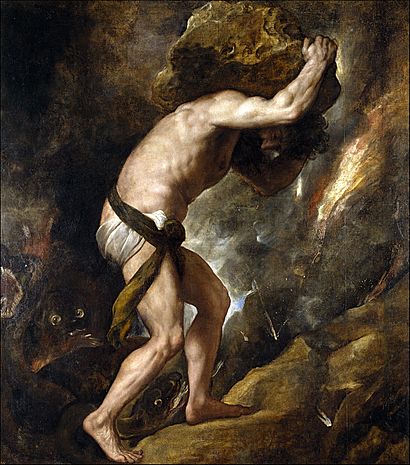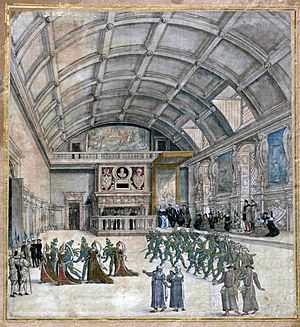Sisyphus (Titian) facts for kids
Quick facts for kids Sisyphus |
|
|---|---|
 |
|
| Artist | Titian |
| Year | 1548–1549 |
| Medium | Oil on canvas |
| Dimensions | 237 cm × 216 cm (93 in × 85 in) |
| Location | Museo del Prado, Madrid |
Sisyphus (Spanish: Sísifo) is a famous oil painting by the Italian artist Titian. He painted it in 1548 or 1549. You can see this painting at the Museo del Prado museum in Madrid, Spain.
Contents
The Story of Sisyphus
This painting shows a scene from ancient Greek mythology. It tells the story of Sisyphus, who was known as a very clever man.
In the Greek underworld, Sisyphus was given a special punishment. He had to roll a huge stone up a very steep hill. But just before the stone reached the top, it would always roll back down. This meant Sisyphus had to start all over again, forever. This endless task is what Titian shows in his painting.
Titian got the idea for this painting from an old Roman poem. It was called Metamorphoses by a writer named Ovid. This poem talks about many people who faced eternal punishments in the underworld.
How the Painting Was Made
Titian painted Sisyphus for Queen Mary of Hungary. She was the sister of Emperor Charles V. She asked Titian to paint two or three large pictures. These paintings were meant to show the punishments of Sisyphus, Tantalus, and Tityus.
Titian finished Sisyphus and another painting, Tantalus, by the middle of 1549. They were put in the Great Hall of Queen Mary's Summer Palace in Binche. The last painting in the series, Tityus, was painted a few years later, around 1553.
Later, Queen Mary took her art collection to Spain. The paintings hung in the Alcázar Palace in Madrid. The room where they were displayed was even called "the room of the Forces." Over time, the Tantalus painting was lost. For a while, people thought Sisyphus and Tityus were copies made by another artist. But experts like Georg Gronau and Charles Ricketts later agreed. They said these paintings were indeed original works by Titian himself. They show his amazing skill and colors.
Where Has the Painting Been?
This is where the painting has been over the years:
- 1700—It was part of the Royal Collection at the Royal Alcázar in Madrid.
- 1747–1818—It was moved to the New Royal Palace in Madrid.
- 1819–present—It has been at the Museo del Prado in Madrid.
Gallery
-
Titian: Sisyphus (1549)
Want to Learn More?
 In Spanish: Sísifo (Tiziano) para niños
In Spanish: Sísifo (Tiziano) para niños
- List of works by Titian
- The Myth of Sisyphus
Where We Got Our Information
- Falomir Faus, Miguel (2003). "Sisyphus". Museo Nacionel del Prado. Retrieved 21 August 2022.
Attribution:
 This article incorporates text from a work in the public domain: Gronau, Georg (1904). Titian. London: Duckworth and Co; New York: Charles Scribner's Sons. pp. 155–156, 194, 305.
This article incorporates text from a work in the public domain: Gronau, Georg (1904). Titian. London: Duckworth and Co; New York: Charles Scribner's Sons. pp. 155–156, 194, 305. This article incorporates text from a work in the public domain: Ricketts, Charles (1910). Titian. London: Methuen & Co. Ltd. pp. 119, 187, plate cxii.
This article incorporates text from a work in the public domain: Ricketts, Charles (1910). Titian. London: Methuen & Co. Ltd. pp. 119, 187, plate cxii.




